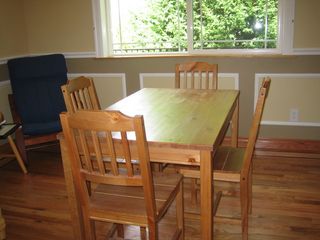What Does It Look Like to Be Blind
How Do Blind People Picture Reality?

Paul Gabias has never seen a table. He was born prematurely and went blind shortly thereafter, most likely because of overexposure to oxygen in his incubator. And still, Gabias, sixty, has no problem perceiving the table next to him. "My image of the tabular array is exactly the same every bit a tabular array," he said. "It has summit, depth, width, texture; I can film the whole affair all at once. It just has no colour."
If y'all have trouble constructing a mental picture of a table that has no color — non even black or white — that's probably because you lot're blinded by your ability to see. Sighted people visualize the surrounding world by detecting borders between areas rich in different wavelengths of lite, which we see as different colors. Gabias, similar many blind people, builds pictures using his sense of touch, and by listening to the echoes of clicks of his natural language and taps of his cane equally these sounds bounciness off objects in his surroundings, a technique called echolocation.
"There'due south plenty of imagery that goes on all the time in bullheaded people," he told Life'southward Little Mysteries. "It just isn't visual."
As well equally beingness bullheaded himself, Gabias is an associate professor of psychology at the University of British Columbia who conducts enquiry on perceptual and cerebral aspects of blindness. His personal and professional experience leads him to believe that the brains of blind people piece of work effectually the lack of visual information, and find other means to reach the aforementioned, vitally of import result: a detailed 3D map of space.
The brain region neuroscientists normally think of as the "visual" cortex, rather than being left to languish, plays a cardinal role in the bullheaded's mental mapping process. [Do Colorblind People Dream In Color?]
In sighted people, visual information first goes to the visual cortex, which is located in the occipital lobe at the dorsum of the encephalon. From at that place, it goes to the parietal lobe, sometimes referred to every bit the "where organisation" because information technology generates awareness of a sensed object'south location. Next, the data is routed to the temporal lobe, also known as the "what system" because it identifies the object.
Evidence from recent brain-imaging experiments indicates that blind people'south brains harness this same neural circuitry. "When blind people read Braille using bear on, the sensory data is being sent to and processed in the visual cortex," said Morton Heller, a psychologist who studies spatial knowledge and incomprehension at Eastern Illinois University. "Using bear on, they get a sense of infinite" — and the relative locations of the raised dots that course Braille messages — "that's not visual, information technology's just spatial."
For blind people who are practiced at echolocation, sound information routes through the visual cortex as well. Their brains utilize echoes to generate spatial maps, which are sometimes so detailed that they enable mountain biking, playing basketball and safely exploring new environments. In fact, terminal year, Canadian researchers discovered that even when blind echolocation experts listened to sound recordings of their natural language clicks echoing off different objects, they could easily identify the objects that had been present at the time of the recordings. Scans with functional magnetic resonance imaging (fMRI) showed activity in areas of their brains associated with visual processing. In other words, their brain scans resembled those of a sighted person identifying an object in a photo.
Clearly, detecting visual contrasts is only one method of many for perceiving reality. But when trying to imagine a world perceived using hearing or impact, one tends to automatically picture echoes and textures generating a visual prototype built out of contrasts between light and night. Gabias cannot excogitate of light and nighttime. So what, exactly, are his mental images like?
"I just moving picture tables. Nosotros have no thought what our brain is doing. Nosotros just perceive — that's the wonderful thing almost it. This is all 'psychologization' that has fabricated it complicated to explain, but elementary to do. You don't know how you lot perceive. You lot just practise it," he said.
"If you know that bullheaded people know where to put their plates on their table, and you know that blind people deal with tables in the exactly the same way y'all do, then you presume that they imagine them in the same way you do. You accept got to presume that what'south inside their caput is like yours."
This story was provided by Life'south Little Mysteries, a sis site to LiveScience. Follow Natalie Wolchover on Twitter @nattyover or Life's Little Mysteries @llmysteries. Nosotros're too on Facebook & Google+.
Source: https://www.livescience.com/23709-blind-people-picture-reality.html

0 Response to "What Does It Look Like to Be Blind"
Post a Comment